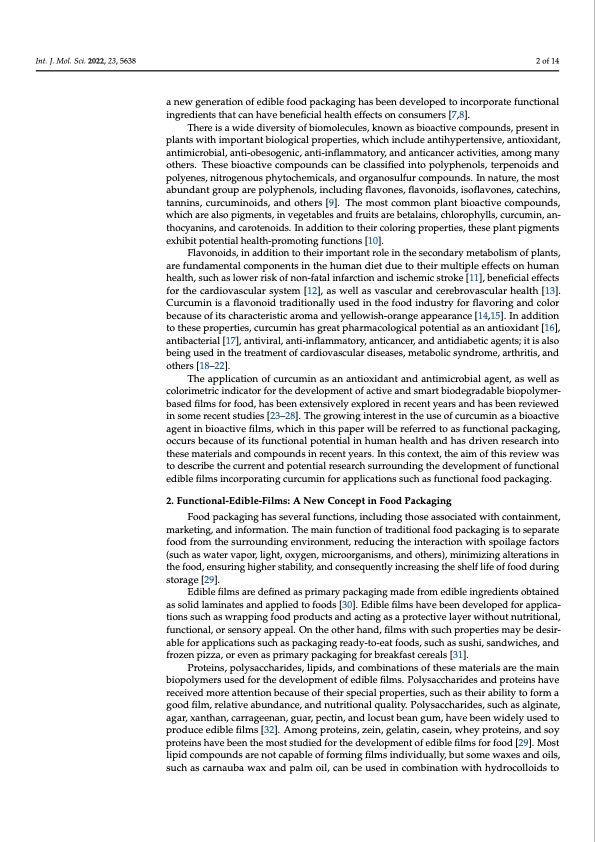
PDF Publication Title:
Text from PDF Page: 002
Int. J. Mol. Sci. 2022, 23, 5638 2 of 14 a new generation of edible food packaging has been developed to incorporate functional ingredients that can have beneficial health effects on consumers [7,8]. There is a wide diversity of biomolecules, known as bioactive compounds, present in plants with important biological properties, which include antihypertensive, antioxidant, antimicrobial, anti-obesogenic, anti-inflammatory, and anticancer activities, among many others. These bioactive compounds can be classified into polyphenols, terpenoids and polyenes, nitrogenous phytochemicals, and organosulfur compounds. In nature, the most abundant group are polyphenols, including flavones, flavonoids, isoflavones, catechins, tannins, curcuminoids, and others [9]. The most common plant bioactive compounds, which are also pigments, in vegetables and fruits are betalains, chlorophylls, curcumin, an- thocyanins, and carotenoids. In addition to their coloring properties, these plant pigments exhibit potential health-promoting functions [10]. Flavonoids, in addition to their important role in the secondary metabolism of plants, are fundamental components in the human diet due to their multiple effects on human health, such as lower risk of non-fatal infarction and ischemic stroke [11], beneficial effects for the cardiovascular system [12], as well as vascular and cerebrovascular health [13]. Curcumin is a flavonoid traditionally used in the food industry for flavoring and color because of its characteristic aroma and yellowish-orange appearance [14,15]. In addition to these properties, curcumin has great pharmacological potential as an antioxidant [16], antibacterial [17], antiviral, anti-inflammatory, anticancer, and antidiabetic agents; it is also being used in the treatment of cardiovascular diseases, metabolic syndrome, arthritis, and others [18–22]. The application of curcumin as an antioxidant and antimicrobial agent, as well as colorimetric indicator for the development of active and smart biodegradable biopolymer- based films for food, has been extensively explored in recent years and has been reviewed in some recent studies [23–28]. The growing interest in the use of curcumin as a bioactive agent in bioactive films, which in this paper will be referred to as functional packaging, occurs because of its functional potential in human health and has driven research into these materials and compounds in recent years. In this context, the aim of this review was to describe the current and potential research surrounding the development of functional edible films incorporating curcumin for applications such as functional food packaging. 2. Functional-Edible-Films: A New Concept in Food Packaging Food packaging has several functions, including those associated with containment, marketing, and information. The main function of traditional food packaging is to separate food from the surrounding environment, reducing the interaction with spoilage factors (such as water vapor, light, oxygen, microorganisms, and others), minimizing alterations in the food, ensuring higher stability, and consequently increasing the shelf life of food during storage [29]. Edible films are defined as primary packaging made from edible ingredients obtained as solid laminates and applied to foods [30]. Edible films have been developed for applica- tions such as wrapping food products and acting as a protective layer without nutritional, functional, or sensory appeal. On the other hand, films with such properties may be desir- able for applications such as packaging ready-to-eat foods, such as sushi, sandwiches, and frozen pizza, or even as primary packaging for breakfast cereals [31]. Proteins, polysaccharides, lipids, and combinations of these materials are the main biopolymers used for the development of edible films. Polysaccharides and proteins have received more attention because of their special properties, such as their ability to form a good film, relative abundance, and nutritional quality. Polysaccharides, such as alginate, agar, xanthan, carrageenan, guar, pectin, and locust bean gum, have been widely used to produce edible films [32]. Among proteins, zein, gelatin, casein, whey proteins, and soy proteins have been the most studied for the development of edible films for food [29]. Most lipid compounds are not capable of forming films individually, but some waxes and oils, such as carnauba wax and palm oil, can be used in combination with hydrocolloids toPDF Image | Edible Bioactive Film with Curcumin

PDF Search Title:
Edible Bioactive Film with CurcuminOriginal File Name Searched:
ijms-23-05638.pdfDIY PDF Search: Google It | Yahoo | Bing
Salgenx Redox Flow Battery Technology: Salt water flow battery technology with low cost and great energy density that can be used for power storage and thermal storage. Let us de-risk your production using our license. Our aqueous flow battery is less cost than Tesla Megapack and available faster. Redox flow battery. No membrane needed like with Vanadium, or Bromine. Salgenx flow battery
| CONTACT TEL: 608-238-6001 Email: greg@salgenx.com | RSS | AMP |